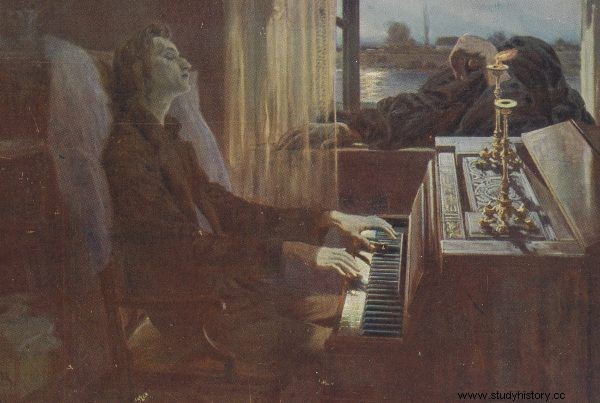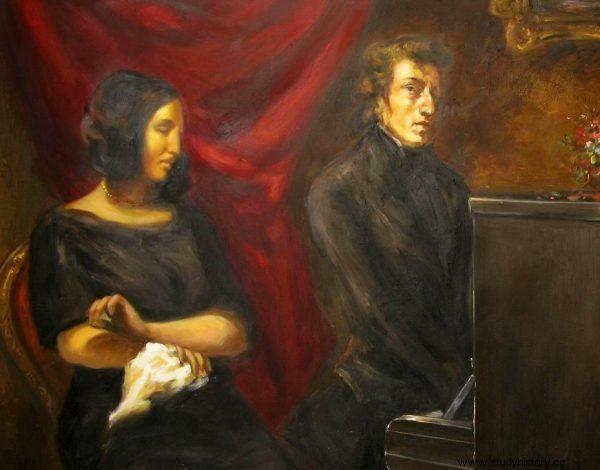This musical genius left behind not only a fascinating work, but also an extraordinary story of life and premature death, which is still intriguing today. Although it is assumed that he died of tuberculosis, there are many alternative hypotheses. What really killed one of the most famous Poles?
Born as the second of four children (and the only son) of Mikołaj and Tekla Justyna Chopin, Fryderyk did not enjoy good health from an early age. His family home was filled with love and a warm atmosphere that encouraged his offspring to develop artistically, but the frequent visits of doctors cast a shadow over the composer's childhood.
Childhood overshadowed by disease
It soon turned out that young Chopin was a sensitive and delicate boy. He did not tolerate fatty meals. He had stomach problems after them, and thus - he was losing weight significantly. This, along with recurring respiratory infections, hindered his normal development.
He was easily tired, so he avoided physical exertion. Doctor Kuzemko, who studied the history of Chopin's illness, mentions his eating habits and treatments that allow him to stay fit and healthy:
He was successfully treated with "oats and honey" and the belladonna leaf treatment that he continued for most of his life. "I am quite healthy ... as long as I avoid meats, sauces, soups, etc." he wrote in a letter to his parents from Berlin on September 27, 1828.

Chopin's health problems accompanied him from an early age.
Fryderyk's youngest sister, Emilia, also struggled with health problems. As Barbara Wachowicz writes in the book Sercem Polak. A Tale of Chopin ":" The only shadow that cast on Chopin's boyhood years were the constant problems with the health of his youngest sister Emilka, and, unfortunately, of himself ".
The girl struggled with recurring cough, shortness of breath and asthma. Over time, she also began to suffer from hemoptysis. Neither the family trip to the spa helped, nor the methods of therapy of the time, mentioned by Wachowicz:"Letting go of blood, lungs," wolfslyka "- these were the treatments for tuberculosis patients in the early nineteenth century.
Emilia died at the age of 14 from a massive gastrointestinal haemorrhage. However, there are suspicions that apart from the indescribable emptiness caused by her departure, the girl caused havoc of a completely different kind. Fryderyk could also have contracted tuberculosis from her - a disease that became as fashionable in the 19th century as crinoline and laudanum.
Suchotnik - the ideal of a 19th century artist
Two hundred years ago, tuberculosis became a kind of phenomenon. Its glorification began at the end of the 18th century, when it "entered" the salons from under thatched roofs, gaining the status of an affliction of the chosen ones - artists, members of the elite and ethereal women. Its hallmark was the premature extinguishing of young, talented people, which perfectly fit into the romantic landscape of the era. As Mateusz Szubert writes:
The consequence of the positive valorization of disease states was the triumphant process in the first decades of the 19th century and still valid in later years, the process of mythologizing the patients themselves. This probably should explain the admiration for the sick body; about the dying Chopin, a few days before his death, one of the French ladies will say: "Ah, how deliciously he coughs" .
This delight turned into ... fashion at some point. Healthy young people even used various methods to make themselves unique through the appearance of tuberculosis. How? They drank vinegar and lemon juice or did not sleep at night to "get" pale complexion and dark circles under the eyes.
It is therefore not surprising that Chopin has become an almost canonical example of a consumptive artist. A young, beautiful genius, creating extraordinary music and marked by the curse of emigration wandering prematurely left this world after a heroic fight with the disease ... This idealized image, however, concealed the tragedy of a suffering man consciously walking towards death.
The way to the end…
The 1830s were for Chopin a period of constant struggle with relapses. He had better and worse times, but was never able to fully heal from his ailments. They haunted him like bad dreams - chronic colds, headaches, laryngitis, bronchitis and hemoptysis.
In addition to the aforementioned belladonna treatment, Fryderyk also treated himself with opium on sugar, better known as laudanum. However, these therapies did not serve him particularly well. Extremely skinny, 170 centimeters tall at the age of 28, he weighed just 45 kilograms.
Rapid relapses from time to time chained him to bed, and his absence from the salons provoked rumors of death circulating all over Europe. Chopin had to explain them, assuring his worried parents, who still lived in Poland, of their good health. He also colored it a bit, because in fact he was never in full strength.

Chopin's health deteriorated more and more. The composer was terribly thin and exhausted by disease.
Health problems also had an impact on his love life, becoming the reason for breaking off the engagement with Maria Wodzińska. Her family insisted on the separation of the young precisely because of the composer's uncertain future - due to numerous illnesses he was predicted to die prematurely.
In 1838, Fryderyk found consolation in the arms of George Sand. The couple and their two children, Sand, left for a romantic winter in Majorca. The composer almost cost this trip his life. Terrible weather, lack of hospitality on the part of the inhabitants and the change of diet forced by local conditions led to a ruin of Chopin's health. The pianist's life was probably saved by his hasty departure from the island and his return to Paris.
For better or for worse
In the following years, Fryderyk's health was marked by a sine wave of better and worse moments. The summer months spent in Nohant, George Sand's country estate, were a respite for his body - and an inspiration for his creativity. Barbara Wachowicz writes about these days in her book Sercem Polak. A story about Chopin ”:
The house smells of grape preserves that George makes, chirping a child, you can hear Solange laughing (daughters of George Sand - editor's note). Dom. A real home. Chopin enjoys the family atmosphere which he has so lacked since his happy youth in Warsaw.
Unfortunately, this idyllic picture finally faded into thin air. The romance of George and Frederick came to an end. It was not without a scandal. Sand published a novel "Lukrecja Floriani", telling the story of an unhealthy relationship between a mature artist and a younger, morbidly jealous prince, in whom many saw a caricature of Chopin.

Chopin's relationship with the writer George Sand ended in an atmosphere of scandal. It was bad for the health of the composer.
After these events, the virtuoso accepted the invitation of his apprentice Jane Stirling and left for Great Britain. He was warmly welcomed in England and Scotland, but his deteriorating health became more and more apparent. Julis Selingmann, who attended Fryderyk's concert in Manchester, recalled:“ Chopin was seriously ill. His strike was extremely weak and although the grace, elegance and delicacy of interpretation appealed to the audience very much, at times the lack of strength made his game monotonous ".
Frederick returned to France at the end of 1848. He felt worse and worse, although in a momentary recuperation he wrote a comforting letter to his mother, in which he assured him that his health had improved. Unfortunately, this optimism was deceptive. In June 1849, Chopin asked his beloved sister Ludwika to come to him, realizing that this might be their last meeting.
Question marks
His feelings came true - he died on October 17, 1849 at the age of 39. According to Dr. Kuzemko:“The autopsy was carried out by Professor Jean Cruveilhier, an outstanding Paris pathologist, anatomist and physician, and an authority in the field of consumption. He issued a death certificate and wrote a medical report. Both documents are lost. ”
The lack of official documents stating the cause of the pianist's death and the long list of his numerous ailments have led to many theories as to what actually killed Chopin. Apart from the most popular thesis, supported by the memories of his relatives and the artist's doctors, that he suffered from tuberculosis, there was an assumption that he suffered from cystic fibrosis . This hypothesis was first put forward by John O'Shea.
The whole history of Chopin's disease (from childhood onwards), as well as the symptoms that led to the death of his sister Emilia, spoke for cystic fibrosis. However, these symptoms could also indicate a deficiency of alpha 1-antitrypsin. This theory was strongly defended by Dr. Kuzemko, who presented his observations and analyzes in 1994.

There are also a lot of other more or less probable hypotheses - from acquired heart defect, through Churg-Strauss syndrome, ending with chronic lung abscess. All these theories circulated in the medical world, but none of them could be categorically refuted or confirmed - until.
Answers to the bothering doctors and music lovers question about the cause of Chopin's death were finally given by ... his heart, which returned to Poland with Ludwika. Fryderyk's sister first kept them in her Warsaw apartment, and then handed them over to the church of St. Cross in Krakowskie Przedmieście, where it remains to this day (except for the turbulent period of the Warsaw Uprising, when it was transferred to Milanówek). As Barbara Wachowicz writes in the book Sercem Polak. A story about Chopin ”:
The last chapter in the history of Chopin's heart was written in 2014. On the night of April 14-15, scientists conducted a study of the organ. The state of preservation was checked (it was feared that there might have been a leak of alcohol with which it was flooded).
It was believed that a visual inspection of the heart would reveal the direct cause of the composer's death. It turned out that the organ is in excellent condition. It is unexpectedly large for a human heart and is white in color. The changes visible in it suggest that tuberculosis was the direct cause of the composer's death.
